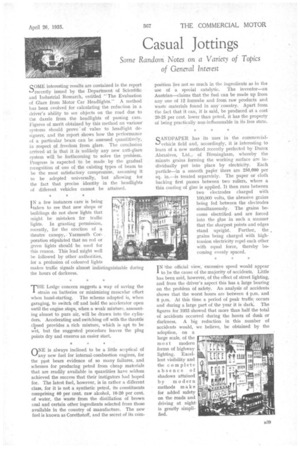Casual Jottings
Page 57

If you've noticed an error in this article please click here to report it so we can fix it.
Some Random Notes on a Variety of Topics of General Interest
SOME interesting results are contained in the report 1.-)recently issued by the Department of Scientific and Industrial Research, entitled " The Evaluation of Glare from Motor Car Headlights." A method has been evolved for calculating the reduction in a driver's ability to see objects on the road due to the dazzle from the headlights of passing cars. Figures of merit obtained by this method on various systems should prove of value to headlight designers; and the report shows how the performance of a particular beam can be assessed quantitively, in respect of freedom from glare. The conclusion arrived at is that it is unlikely any new anti-glare system will be forthcoming to solve the problem. Progress is expected to be made by the gradual recognition of one of the existing types of beam to be the most satisfactory compromise, assuming it to be adopted universally, but allowing for the fact that precise identity in the headlights of different vehicles cannot be attained.
IN a few instances care is being -"taken to see that new shops or buildings do not show lights that might be mistaken for traffic lights. In granting permission, recently, for the erection of a theatre canopy, Yarmouth Corporation stipulated that no red or green lights should be used for this reason. This lead might well be followed by other authorities, for a profusion of coloured lights makes traffic signals almost indistinguishable during the hours of darkness.
THE Lodge concern suggests a way of saving the strain on batteries or minimizing muscular effort when hand-starting. The scheme adopted is, when garaging, to switch off and hold the accelerator open until the engine stops, when a weak mixture, amounting almost to pure air, will be drawn into the cylinders. Accelerating and switching off with the throttle
closed provides a rich mixture, which is apt to be • wet, but the suggested procedure leaves the plug points dry and ensures an easier start.
ONE is always inclined to be a little sceptical of any new fuel for internal-combustion engines, for the past bears evidence of so many failures, and schemes for producing petrol from cheap materials that are readily available in quantities have seldom achieved the success that their instigators had hoped for. The latest fuel, however, is in rather a different class, for it is not a synthetic petrol, its constituents comprising 40 per cent, raw alcohol, 10-20 per cent, of water, the waste from the distillation of brown coal and certain other ingredients selected from those available in the country of manufacture. The new fuel is known as Corethstoff, and the secret of its corn
position lies not so much in the ingredients as in the use of a special catalytic. The inventor—an Austrian—claims that the fuel can be made up from any one of 12 formula and from raw products and waste materials found in any country. Apart from the fact that it can, it is said, be produced at a cost 20-25 per cent. lower than petrol, it has the property of being practically non-inflammable in its free state.
QANDPAPER has its uses in the commercial vehicle field and, accordingly, it is interesting to learn of a new method recently perfected by Durex Abrasives, Ltd., of Birmingham, whereby the minute grains forming the working surface are individually put into place by electricity. Each particle—in a smooth paper there are 250,000 per sq. in.—is treated separately. The paper or cloth backing first passes between two rollers, where a thin coating of glue is applied. It then runs between two electrodes charged with 100,000 volts, the abrasive grains being fed between the electrodes simultaneously. The grains become electrified, and are forced into the glue in such a manner that the sharpest points and edges stand upright. Further, the, grains being charged with hightension electricity repel each other with equal force, thereby becoming evenly spaced.
the official view, excessive speed would appear to be the cause of the majority of accidents. Little has been said, however, of the effect of street lighting, and from the driver's aspect this has a large bearing on the problem of safety. An analysis of accidents shows that the worst hours are between 4 p.m. and 8 p.m. At this time a period of peak traffic occurs and during a large part of the year it is dark. The figures for 1933 showed that more than half the total of accidents occurred during the hours of dusk or darkness. A big reduction in this number of accidents would, we believe, be obtained by the adoption, on a large scale, of the most modern forms of highway lighting. Excellent visibility and the complete absence of shadows attained by modern methods make for added safety on the roads and driving at night is greatly simplified.




































































































